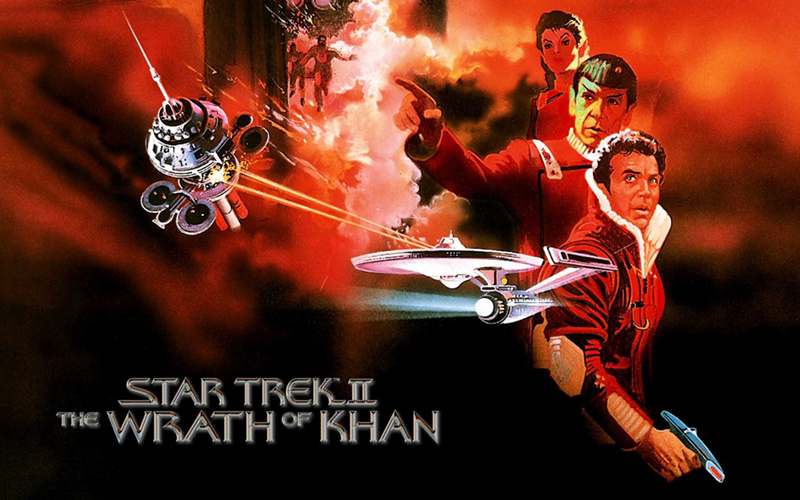Retro Review: Star Trek: Nemesis
8 min readThe new Romulan leader – who has devised a deadly plan for Earth’s future – also has a very personal connection to Picard.
Plot Summary: When Reman leader Shinzon’s plan to unite the Romulans fails in the Imperial Senate, an unfamiliar form of energy kills everyone in the chamber. Not long afterward, the Enterprise’s journey from Earth to Betazed carrying newlyweds Riker and Troi is interrupted by the discovery of a positronic signal on a planet near the Neutral Zone. When the ship diverts, the crew finds a disassembled android who seems to be a prototype for Data. Data downloads his memory into B-4 to help this new brother evolve, but B-4 still has many glitches. Before the Enterprise can resume course to Betazed, Admiral Janeway orders Picard to Romulus, informing him that Shinzon has requested a Federation ambassador for negotiations. Data tells the crew that the Remans are strong warriors but have never been treated as equals by the Romulans. Shinzon’s Viceroy has the senior staff beam aboard the massive warship Scimitar, where Picard is shocked to discover that Shinzon is human…and a clone of himself, even suffering from the same rare genetic hearing disorder. In a private meeting with Picard, Shinzon explains that he was created as part of a plan to replace the Starfleet captain with a clone, but the project was ended and Shinzon was sent to live – or die – in the dilithium mines on Remus as a child, where his Viceroy saved him. Shinzon claims that he only wants peace, yet Troi has nightmares about Shinzon raping her and realizes that he and his Viceroy can manipulate her telepathic abilities.
Shinzon claims that now he wants justice for his Reman brothers, but LaForge has two pieces of bad news: that someone has broken into the main computer, and that deadly thalaron radiation has been detected. The crew discovers that Shinzon is using B-4 to access the Enterprise computers, and his ship is the source of the radiation, which he intends to use to destroy Earth. But first, he needs Picard’s blood, because a flaw in his cloning process means that he will die without a transfusion. Shinzon abducts Picard, but when he thinks he is beaming B-4 aboard, he actually gets Data, who helps Picard escape. A pair of Romulan warbirds under the command of Shinzon’s onetime ally Donatra attempt to help the Enterprise disable the Scimitar, but since the ship is cloaked, Troi must use her link to the Viceroy to track it. A group of Remans beams aboard the Enterprise to bring Picard to Shinzon for the needed transfusion but Worf and Riker are able to stop them until Picard realizes the only hope of disabling the thalaron weapon is to beam over himself to do it. Data leaps through space to reach the Scimitar in time to rescue Picard just after the captain kills Shinzon, though Data is killed destroying the thalaron weapon. After the memorial service, Picard tries to tell an uncomprehending B-4 about Data, and though the android does not yet understand human feeling, he can sing the song Data performed at Riker and Troi’s wedding, leaving Picard hopeful that the rest of Data’s memories will surface as B-4’s positronic brain develops.
Analysis: I have a confession: I never saw Nemesis when it was in movie theaters. The day I was supposed to go, I opted for a repeat viewing of The Lord of the Rings: The Two Towers instead. I was completely infatuated with the Tolkien film franchise, I’d heard nothing but complaints about the last Next Generation film – even the cast didn’t seem enthusiastic about it – and I had the sense that the Star Trek franchise was burned out. The final seasons of Voyager and the initial seasons of Enterprise were giving us plenty of evidence of that. I didn’t get around to watching Nemesis until it came out on DVD, when my family watched it on my parents’ plasma TV, and then I was pleasantly surprised. Not that I thought the Next Gen swan song was a great film, but it’s not a terrible one. There are aspects of it that I like better than aspects of Generations and First Contact. Even so, watching it to work on this review, it’s the first time I’ve revisited the film since that initial viewing. With most Trek, I feel like I’m sorting through 10 or 20 or 30 years of experiences with the material, yet with this one – though obviously I’ve lived with the characters for a couple dozen years – it feels almost fresh, rather than the stale experience I’d expected from the reviews. It’s almost like discovering an episode I’d forgotten existed.
I figured I should get that out of the way because I suspect I might feel differently if I’d paid ten bucks to see Nemesis in the theater (and paid for parking and popcorn and all the things that go along with seeing a film). While Nemesis doesn’t have a bad story, it definitely feels slight compared to the previous Next Gen films – even Insurrection, where there aren’t hundreds of millions of lives at stake. Part of the problem is that so much of it feels recycled, which was perhaps inevitable at the time of its release in the Star Trek franchise, and, to be honest, doesn’t grate on my nerves so much in anything that preceded the reboot, now that I’ve experienced the reboot itself. I started making notes of things that happened in Nemesis that reminded me of things that happened in previous episodes/movies and eventually made myself stop because it was an exercise in frustration. What was the name of the terrible episode with the guy who made Troi see his face when she was making love with other people, was that in “Man of the People” or “Violations”? What was the explanation for the cloning problems on that planet with the stereotypical Irish people and the asexual reproduction crowd? There’s plenty in Insurrection that borrows from TV episodes without bugging me too much, so the real question is, does Nemesis make good use of what it recycles? I’m afraid the answer is “not really” but that doesn’t have to be a deal-breaker if the characters are spot on.
So about those characters…well, there’s good news and bad news. I’ve been a Riker/Troi fan right from the start, though I’m not sorry they weren’t a couple for so many years – I appreciated the way Worf and Troi grew together, and grew apart, and I wouldn’t want to toss out “The Outcast” to have Riker in a monogamous relationship, plus I enjoyed his fling with Ro and Crusher dealing with Odan in Riker’s body. There’s something very satisfying about knowing they ended up together not because it was convenient and cute but because their myriad experiences have brought them full circle. Even abbreviated, the wedding scene is a delight, with Wesley and Guinan putting in appearances as Picard faces the prospect of someone other than Riker in the first officer’s chair and Worf, having drunk too much Romulan ale, learns that everyone will be naked at the wedding on Betazed. I’m not crazy about Data singing, I preferred his classical music phase, but it’s actually relevant to the plot for once to have a character breaking into song. Like the other movies, Picard and Data receive most of the character development, so it’s nice to see a party for someone else kick things off. There are plenty of references to the larger Trek universe, too: Riker uses a maneuver named after Captain Kirk, Data reports on the Remans’ capabilities during the Dominion War, Janeway gives Picard orders (okay, I find it hard to swallow that she became an admiral before he did, but I guess her multiple Borg assimilations trump his).
But the most obvious references are to The Wrath of Khan, when another character made the logical decision to sacrifice himself to save his crew after another captain faced down a foe so damaged that no appeals to his great intellect made a dent. (For better or worse, we even get the same hints that resurrection may be possible.) Which begs the question: is it worth it? Shinzon at first seems charismatic enough to be a Picard even if the physical resemblance is slight – something explained by Reman radiation and gravity, plus repeated facial injuries to the young clone – but either he goes mad as his condition worsens or he’s badly written, because in the end, he isn’t even pitiable; I felt sorrier for Lore when Data had to deactivate him. Which is certainly a parallel the filmmakers may wish, because they create one for Data too, a prototype which – as Data says – has no ambition, no impulse to try to be more than he is. I don’t know whether to be upset with B-4 for secretly working for Shinzon, which after all is only what he’s programmed to do, or to be upset with LaForge and Data, who hook B-4 up to their systems without so much as a virus scan. I’m not sure it makes a difference anyway, since it’s Data’s ability to pass for B-4 that ultimately defeats Shinzon. His decision to die seems in part motivated by guilt that yet again a Soong android has put everyone he cares about in jeopardy, because I’m just not clear why he couldn’t otherwise have brought over an extra signal booster or whatever he needs and beam out at the last second like he’s done before. As Janeway says to Picard, the Enterprise has faced the the Borg – tough assignments are typical, and despite the awesome power of the Scimitar and its new weapon, this one just doesn’t seem deadly enough to kill off Data, just as a lot of people felt Soran wasn’t worthy to have killed Kirk.
In any series with a major Vulcan character, the introduction of the Remans could have been wonderful – Spock, Tuvok, T’Pol would all want to know about their common ancestors and how Romulan-Reman development diverged so radically. But no one really cares about the fate of the Remans once it becomes apparent that their human leader is mad, and there’s no evidence that Donatra (whom I love, since she reminds me of the Romulan Commander from “The Enterprise Incident”) will fight for their rights once this internal security matter is settled. I wish there was more focus on that issue, which would have been the meat of a good episode, without the gratuitous bits like yet another mind-rape of Troi in a scene that’s perfectly horrible to watch and quite unnecessary in its detail. I’m also not sure why the Argo vehicle chase to retrieve B-4 is so overexposed that it’s blinding for viewers; I’d have preferred more attention to Data and how he feels about finding a potential sibling who could be another Lore. “Look in the mirror, Captain!” indeed. My kids were deeply impressed with the Scimitar and we all appreciated getting to hear the spacedock music from Star Trek: The Motion Picture, but given that this closes a chapter, I understand why for so many fans, it’s not enough to get a fair-to-middling episode to close out the Next Gen franchise.






